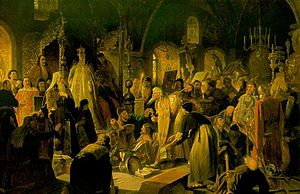Religion has always played a key role in history, causing wars and territorial disputes, things like crusades and the Spanish Inquisition; in fact we actually measure time periods from whether they were before or after the birth of Christ. Therefore, it’s no surprise that religion did have a role in the transition from tsarist Russia to the formation of a Republic of Russia.
A little overview of Eastern and Western Christianity
The Russian empire had its own branch of religion called the Russian Orthodox Church, which was one of the biggest branches of Eastern Orthodox Christianity, which is one of the three main groups of Christianity (Catholic, Protestant, and Orthodox). Much like the two other branches in the Western world, the Orthodox Church believes in the birth and death of Jesus and that he was God Incarnate, however there are some differences in things like traditions, with the Orthodox Church placing an incredible emphasis on prayer.
Originally, the two sides of Christianity, Eastern and Western, began to divide in the 8th century, in around 787CE and most believe the spilt to be finalised in around 1054CE due to a major dispute over the Pope’s claim to supreme authority and the doctrine of the Holy Spirit. One later result of this split is that, while Latin became the language of the Western Church, Eastern churches generally kept to the local language. Also, in the Bible of the Orthodox Church, the Old Testament is based not on the Hebrew version, but on and ancient translation from Hebrew into Greek, called the Septuagint.
How was the Russian Orthodox Church structured?

To really understand the history of the Russian Orthodox Church, you have to look back a little further that 1855. Before the 1700s, the ROC was led by a patriarch, mostly separate from the monarchy. However, in the mid-17th century, the Patriarch of the time, a man called Nikon, got into a major conflict with the tsar of the time Alexis for two reasons. Nikon wanted to a) update all the traditions and teachings of the ROC to match up with the general Eastern Orthodox Church, and b) Nikon wanted to establish a theocratic state in which the Church would hold supreme control rather than the state. Unsurprisingly, Nikon was deposed in 1666, but the ROC did keep many of his reform and rejected those who opposed them (this group of people would later become known as the Old Believers and continued to actively oppose the ROC for the next 200 years). The next major change in the Russian Orthodox Church structure was in 1721, under the rule of Peter the Great. Peter abolished the role of the Patriarch of the Church and instead replaced it with something called the Holy Governing Synod. This is a more council like set of rulers, normally made up of bishops who were far more under the control of the state than the former Patriarch was, and this form of ruling continued up until 1917.
The Russian Orthodox Church post-tsarism
After the collapse of tsarism with the abdication of Nicholas II, the Russian Orthodox Church was faced with a problem – now that the Tsar was gone who would be the supreme power? A council of the Russian Orthodox Church decided to re-establish the Patriarch as the head of the Church and selecting a man named Svyatoy Tikhon , much like before the introduction of the Holy Synod in the 1600s. However, this did not last long as the new Soviet government wanted to separate the Church and the State and then nationalised all the land that was previously held by the Church. After the nationalisation of the lands, the Church was then faced with a brutal state-sanction persecution, in which churches were destroyed and many clerics were arrested and then executed. The ROC then faced further problems in 1922 when the Soviet government supported the introduction of an oppositional reformed church, called the Renovated Church, seeded from the Patriarch Tikhon’s church, which then restored a Holy Synod to power. All of this brought lots of division amongst the clergy and the religious population.
Tikhon dies in 1925, and after that the government forbade any sort of patriarchal elections from being held. In 1927, in an effort to keep the Church alive, religious leader Sergius formally declared his loyalty to the government and then stopped criticising the state in any way; this only created further divide within the Church itself – some people understood why he would do that, while others dismissed him, and others, especially Russian religious leaders who were abroad at the time, severed the relations with Moscow entirely.
The church after 1943
In 1943, Stalin, who was the current leader of Russia, suddenly reversed his formerly repressive policies towards religion. This led to an almost resurrection in the Russian Orthodox Church. Theological schools were opened, thousands of churches began to function again, and a new Patriarch was even elected. Between 1945 and 1960, although the were still occasionally some members of the clergy being arrested and exiled, the organisation of the church expanded greatly and by 1960, 25,000 churches were functional.